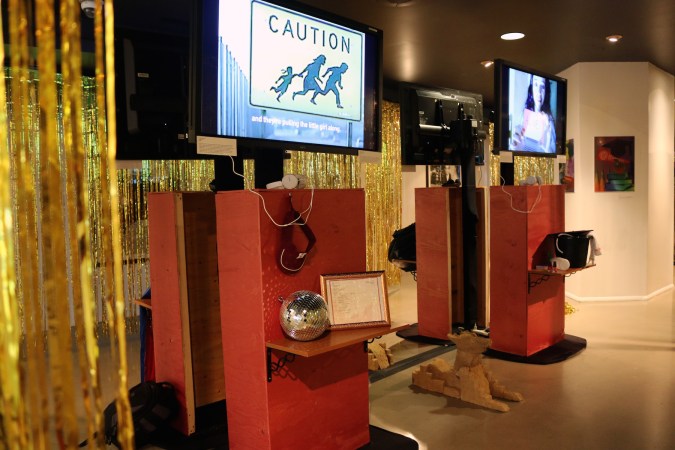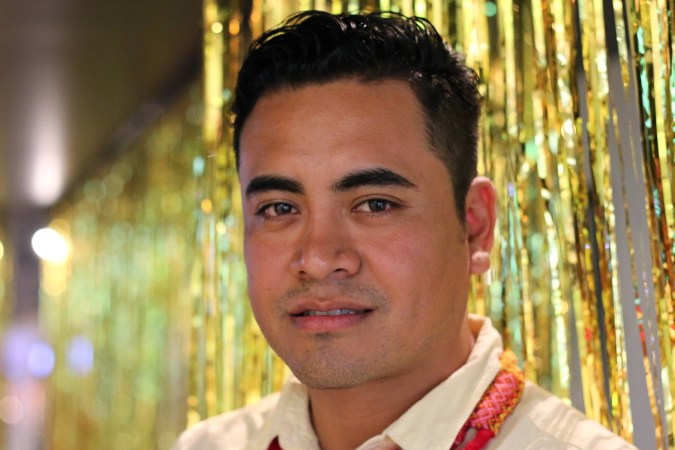Inside Hollywood’s historic Chinese Theater, 16 films made by undocumented people screened in an installation called, “Con Cámaras y Sin Papeles: A Decade of Undocumented Storytelling,” curated for LALIFF this past weekend. As guests made their way into the theater, they passed by curtains of sparkling gold fringe and eight screens lit up with images. Julio Salgado, of the national arts organization CultureStrike, spearheaded the exhibit. As an undocumented artist himself he realized other creators like him had been producing video content for years. He selected projects spanning an array of genres and formats—from experimental and documentary to comedic web series.
Through a collaboration with acclaimed Los Angeles artist Rafa Esparza, who designed the aesthetic component of the installation, the two created a powerful timeline full of nuanced experiences that are often missing from mainstream media. “If we want to see real narratives and stories of undocumented folks we have to be the ones in charge of that narrative,” explains Julio Salgado.
The installation starts with the 2007 short documentary Lost & Found by Tam Tran, an undocumented filmmaker originally from Vietnam. The film follows a Filipina through her struggles trying to attain a degree at UCLA, before the existence of Obama’s Deferred Action for Childhood Arrivals (DACA). Tran, who passed away in 2010, is widely credited as being the first undocumented immigrant to make movies based around the undocumented experience. “She was someone who really inspired us, that because we are undocumented doesn’t mean we can’t grab a camera and film our own stories,” describes Salgado.
Following Tran’s film is Marcos Nieves’ Almost American, about a woman who, after receiving her degree from Harvard, is facing a lack of job opportunities because of her undocumented status and considers self-deportation.
The stories evolve with the immigrants’ rights movement. The 2012 film Limbo follows three storytellers and activists as they film their own lives over the span of three months. Nancy Meza, one of the subjects/filmmakers, was able to capture footage an important act of civil disobedience where activists (including her) shut down the ICE offices in Los Angeles. The event helped push the Obama administration to move forward with DACA.

Limbo allowed the three activists to convey the complexities of how each individual experiences being undocumented. Allies often have a desire to protect immigrants, and opponents of immigrant rights tend to demonize them, causing portrayals of undocumented folks to be simplistic, creating a dichotomy that can lead to further dehumanization. “I feel like the way stories are told about immigrants are really stratified, very polarized. It’s so important for us to have control of our narrative because our stories are complex,” explains Meza.
“I came out as undocumented and unafraid in 2009/2010, and I think a lot of us have shed our fear a long time ago, so we’re at a different place in terms of the kind of stories we want to tell,” says Meza. ‘It’s not about liking immigrants, it’s about believing that we have rights and dignity and respecting us.”
As the installation progresses, visitors are confronted with Xoloitzcuintlis, the hairless dogs known in many indigenous cultures as a spirit guide. These figures are made out of adobe sourced from Texas by the installation curator, Rafa Esparza. Using a recipe handed down by his father, who was a brickmaker in Durango, Mexico, Esparza carves these figures as a way to monumentalize the journeys in the borderlands through material that is representative of immigrant labor—like that of his father’s.
In addition to the xolos, Esparza dispersed a variety of cacti throughout the space. “I wanted to place land and these resilient life forms to further contextualize a space where we can experience our own resilience, resilience of the different folks that are telling these powerful stories,” describes Esparza.
By wrapping these plants in sparkling golden tassels, he mirrors many of the themes the films convey: the undocumented experience is not just tragedy, there’s also joy and laughter and imperfection. “Yes, they are hardworking plants, they thrive in harsh conditions, but they’re also really beautiful, and they bring me joy when I see them. I’m trying to convey that we’re just so much more than a sad and dramatic carrier of memory.”

It was also his choice to encase the installation in hanging golden fringe as a way to create an intimate experience with each film. Each screen is also propped up on a pedestal that’s decorated with source materials from the films, creating an altar of tangible materials for each story. “What we have now is an installation that’s composed of not only moving images, but actual physical material that’s pulled from people who participated in the films,” says Esparza.
As the viewer travels through the exhibition, the screens progress to more recent projects. One such project is Undocumented Tales, a comedic web series about closeted gay man going through the struggles of having to lie to society about being undocumented, and to his family about being gay. Its creator, Armando Ibanez, came to the United States at 18 years old. Despite his childhood love of film, he clearly remembers upon arriving being told to forget about his dreams and goals. “Being undocumented means we don’t have goals, we don’t have dreams. We just get to work, and don’t tell anybody about your undocumented status.”
Years later, Ibanez discovered the Undocumented and Unafraid activist movement, which empowered him to go to school. Then, after a deep depression, a friend told him about Issa Rae’s breakout series, Awkward Black Girl. The series inspired him to create his own web series. It was important for Ibanez to depict the queer and undocumented experience in a way that had never been done before. “Hollywood has always shown that we’re always crying and crossing the border in every movie and documentary, and yes, that is true,” explains Ibanez, “but we also laugh, we also dance, we also fall in love, we have sex, we get drunk, we’re messy, we’re human beings.”
Undocumented Tales helps fill a gap in the representation of this experience that doesn’t exist in mainstream media, despite there being 300,000 undocumented people that identify as part of the LBTQ community. “Representation means telling someone that their life matters,” describes Ibanez.

Most of these films were made with little to no resources, using the help of friends, volunteers, and crowdsourcing. But most importantly, these films were made during difficult times that have spanned a ten years. “Under Obama, we didn’t have DACA. We were facing the strongest deportation machine we had ever had in this country, and in those times of chaos, we were still creating,” explains Nancy Meza. “I think this is a reminder for me that in times of chaos we’ve been able to create and why we need to keep creating and uplifting immigrant voices.”
These creations show the importance of having undocumented people tell their own stories and complicate the “good vs. bad” immigrant narrative that’s all too prevalent in most mainstream media portrayals. These films show sadness and frustration, but also joy and imperfection. “These pieces of work serve as documents that we weren’t just victims. We actually did something about our experiences, our struggle, and we threw it back into the world,” says Salgado.




